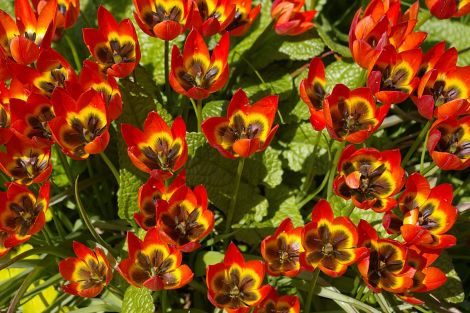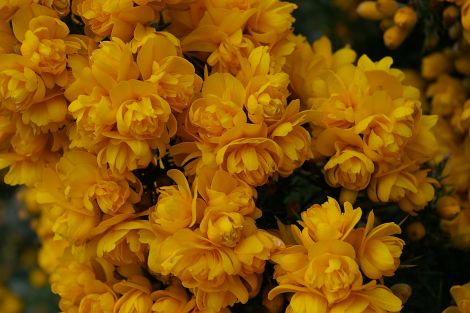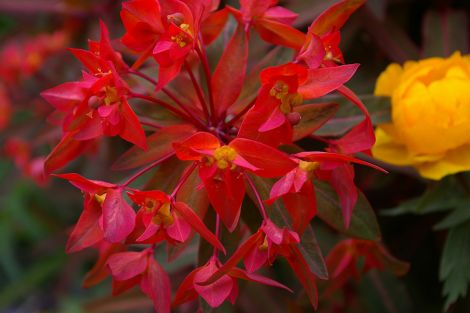Four Seasons / Four Seasons – Late Spring
It’s bad enough pushing a trolley around a supermarket once a fortnight or so without having its contents scrutinised and remarked upon by fellow shoppers. From now on I shall have to do my shopping in disguise in order to avoid personal and envy-inducing comments.
On second thoughts, instead of wandering the Co-op aisles in an Up-Helly-Aa costume, I could get myself a poly-tunnel and join the ranks of those gardening in Mediterranean conditions, rather than toil the soil in solidarity with those still working exclusively in the great outdoors, which hasn’t been exactly great this spring.
My friend, who ticked me off for buying carrots, had obviously never heard of the hungry gap, when the old stores (if ever there were any) have run out and the new crops are far from harvestable.
He is, of course, a poly-tunnel owner, and has feasted on young carrots, peas, asparagus and goodness knows what else, since the first week of May. It was the mention of asparagus, freshly cut asparagus, that made my mouth water and turned me (asparagus) green with envy.
A long list of dream plants along with a permanent labelling system, slug-repellent copper tools and several new paths have ceased to feature as priorities. An otter-proof fence for the pond and an asparagus tunnel now vie for first place in the urgent purchase stakes.
I used to grow asparagus, raised from seed, as a lacy green foil in my White Garden, and for culinary purposes in my small, south-facing greenhouse borders well over twenty years ago, until the soil in the beds was taken over by the greedy, far-reaching roots of several fruit trees, and the asparagus ferns outdoors succumbed to one of those exceedingly wet winters.
Fruit trees and asparagus plants have one thing in common. They are both exceptionally long lived. A well-managed asparagus bed remains productive for two, even three decades, repaying the initial effort and expense many times over. There’s a growing band of asparagus growers in Shetland and if they still stick with traditional cooking methods, I’d advise them to brush their spears with a little olive oil and pop them under a hot grill – it knocks the boiled stuff into a cocked hat. Asparagus is an ideal poly-tunnel crop, but can also be successfully grown under cloches or in large cold-frames, provided the soil is rich and well drained.
Become a member of Shetland News
Cold-frames and cloches have been the order of the day for this year’s vegetable production, and the greenhouse is still overflowing with brassicas, fed daily with diluted, evil-smelling seaweed juice to toughen them up. They should’ve been planted out by now, but our vegetable rig, dug in April, is still a swamp. But, sorrow shared is sorrow halved. Our neighbour Jimmy traditionally plants his kale yard in early April, sometimes in late March, but this year the soil in his yard wasn’t dry enough for ploughing until the third week in May.
There’s no sign of life yet from our tatties, planted in mid-April, and covered with black polythene to stop them from drowning – ‘Duke of York’, a first early, and ‘Pink Fir Apple’, a slow-maturing salad potato. The rest of the crop – blight-resistant cultivars ‘Lady Balfour’ and ‘Sarpo Mira’ followed a month later, just before our annual little summer started.
A little heat does wonders for the plants and the energy of the gardener. 132 leeks stand in proud rows, the first salad leaves, started off in the greenhouse, are ready to pick, the radishes are growing plump, and the courgette plants have doubled in size since being released into the garden from their all too small pots.
The progress of the ornamental garden, miles ahead after a mild winter, had slowed down to a snail’s pace due to the unseasonably cold weather, holding back the flowering of many treasures. And should there be another cold snap, the first “hot” colours amongst May and June’s pinks, whites and blues, bring a little virtual warmth.
Tulipa ‘Little Princess’ is perfect for the rockery and smoulders in orange, yellow and black. Wild gorse flowers all year round, but Ulex europaeus ‘Irish Double’ puts its all into a late spring display when intense saffron yellow is matched by an intense coconut scent.
Greenish yellow is the predominant colour of the spurge family, but the terminal leaves and floral bracts of the Himalayan Euphorbia griffithii glow in orange and vermillion. The German cultivar ‘Wickstede’ is especially dark and smouldering and perfect for the smaller garden with a more compact habit and less appetite for horizontal expansion than the species.
The garden’s fauna carries on regardless of the weather; the tadpoles are growing fat on a diet of blanket weed, the first young blackbirds are on the wing, and our pair of wood pigeons (Columba palumbus) has at long last completed its flimsy nest and decided to raise its annual squab.
Rosa Steppanova – www.leagardens.co.uk
Become a member of Shetland News
Shetland News is asking its readers to consider paying for membership to get additional perks:
- Removal of third-party ads;
- Bookmark posts to read later;
- Exclusive curated weekly newsletter;
- Hide membership messages;
- Comments open for discussion.
If you appreciate what we do and feel strongly about impartial local journalism, then please become a member of Shetland News by either making a single payment, or setting up a monthly, quarterly or yearly subscription.











